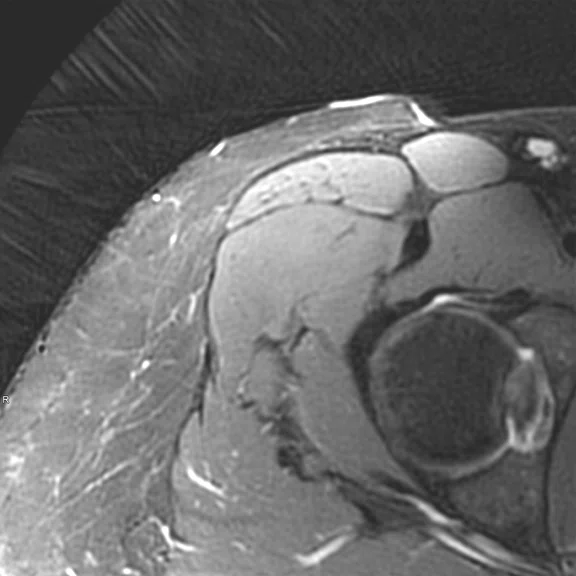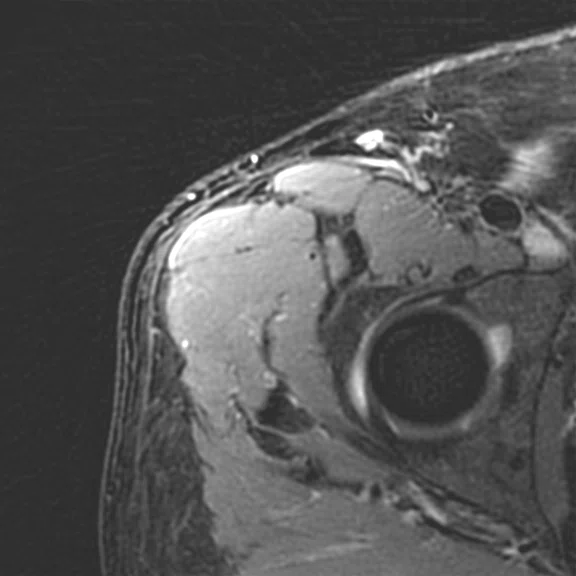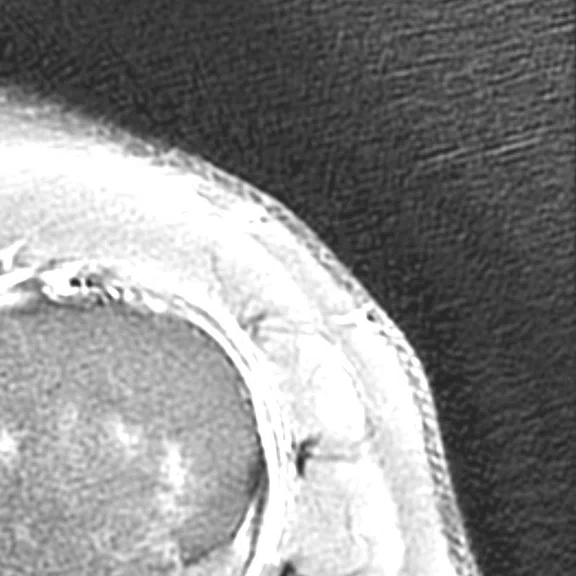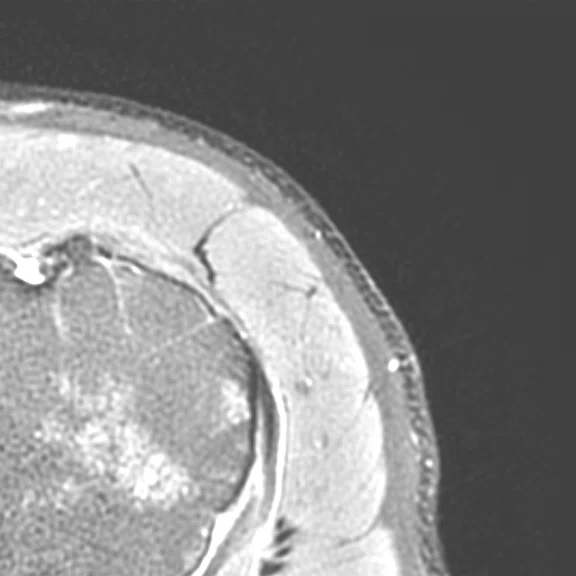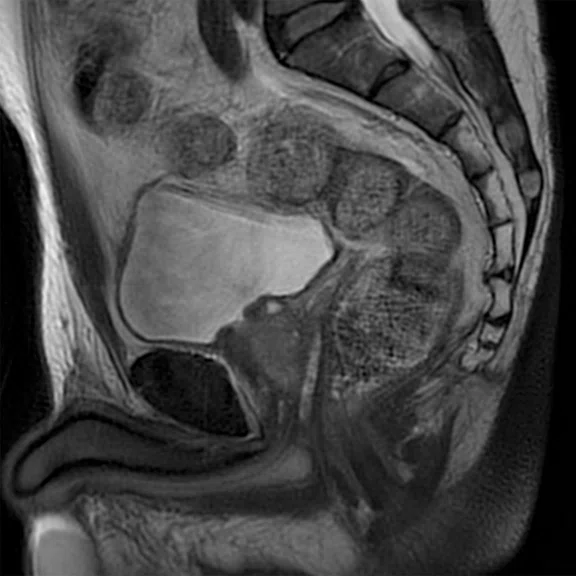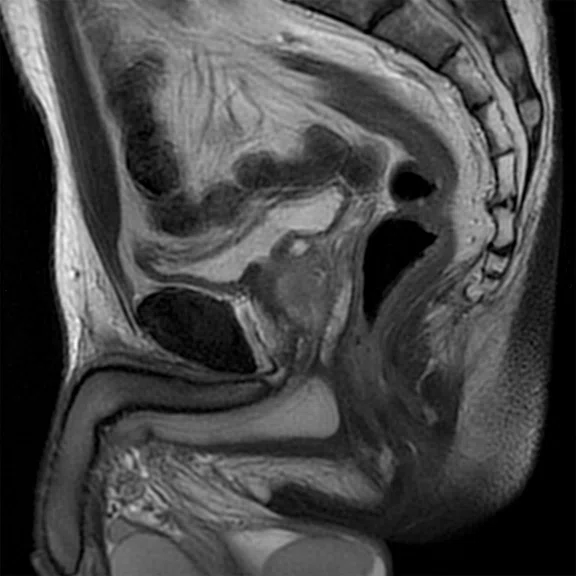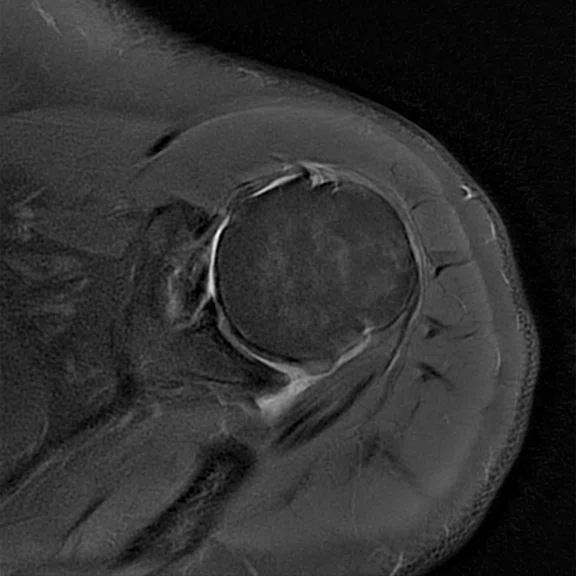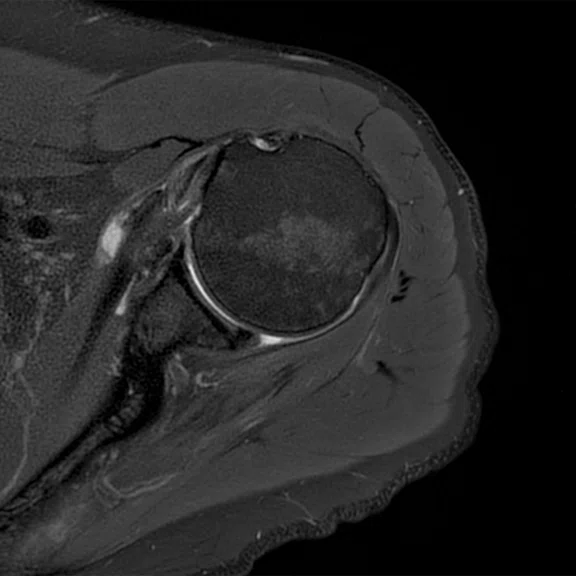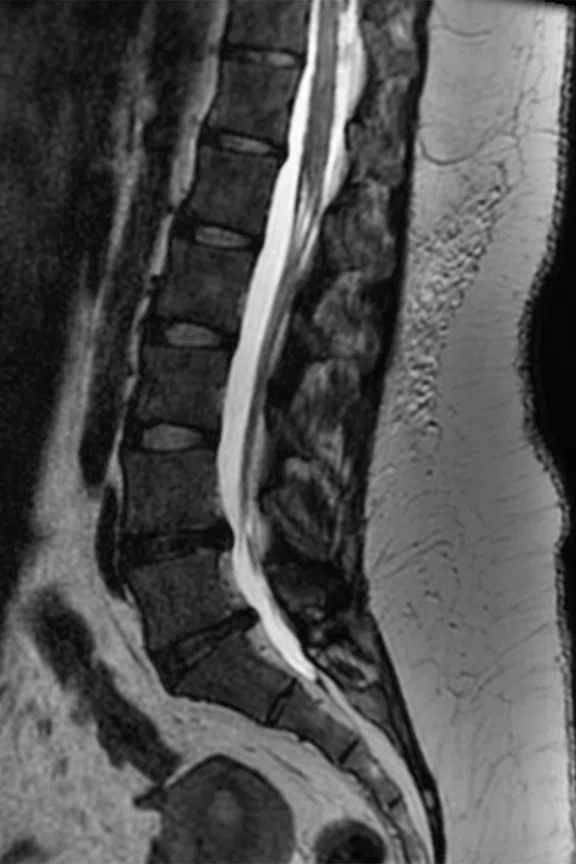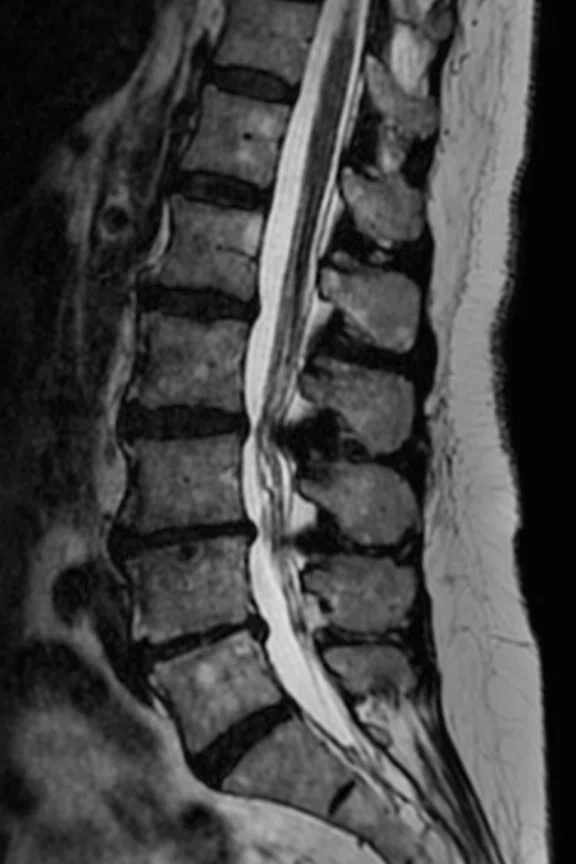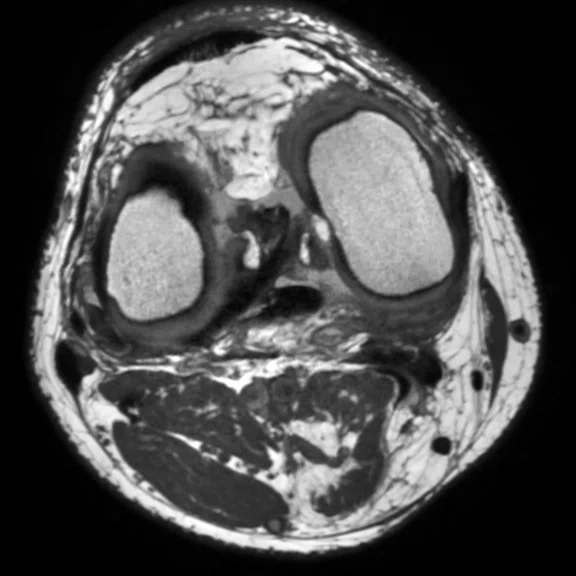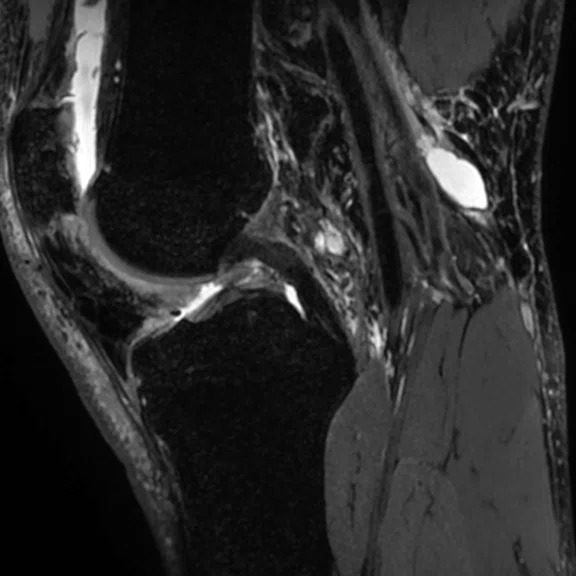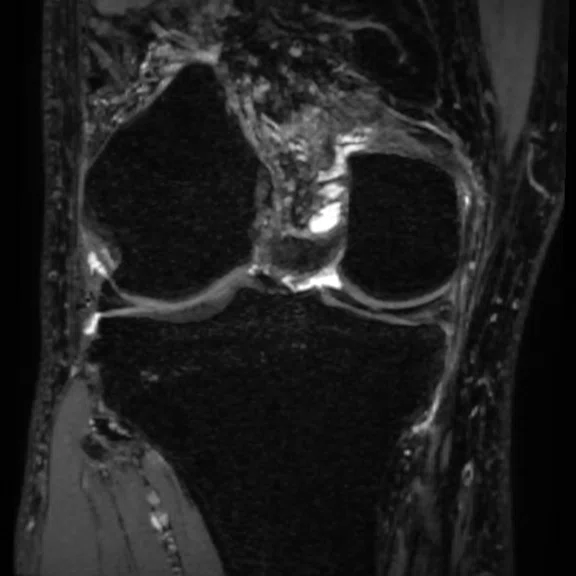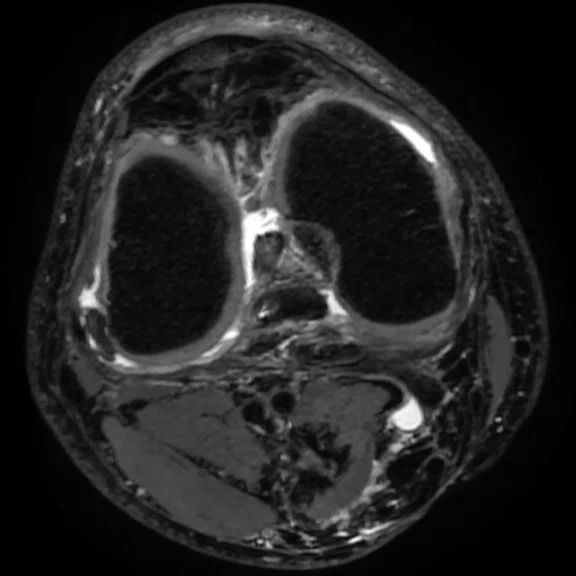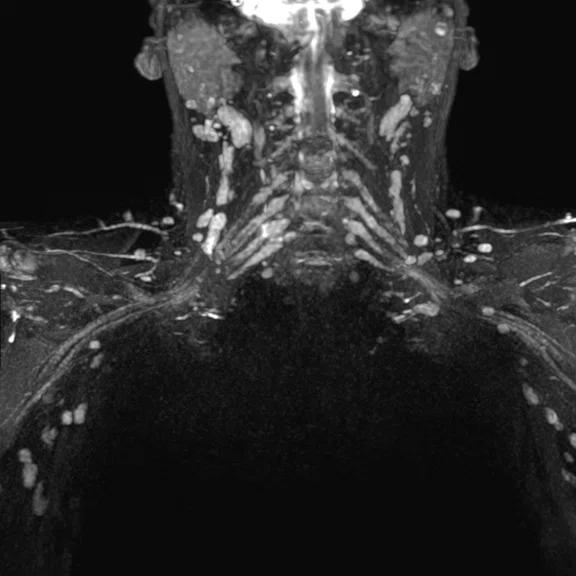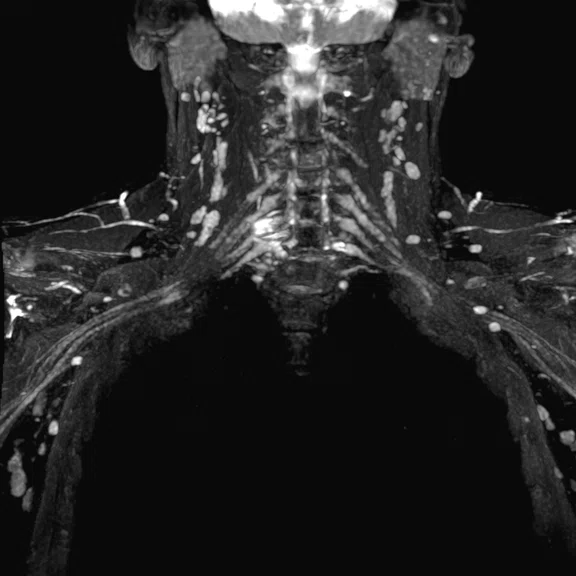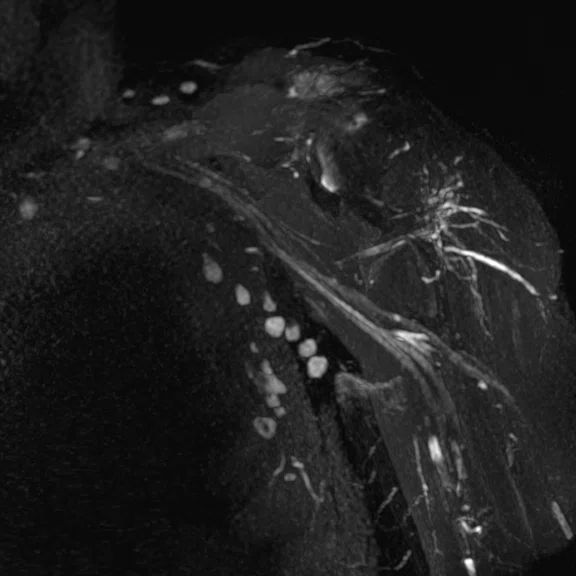‡Not yet CE marked for 1.5T. Not available for sale in all regions.
1. Villanueva-Meyer J, Shin D, Li Y, et al. Denoising MR Images of the Cervical Spine: Multi-Reader Assessment of a Deep Learning Approach. Radiological Society of North America 2019 Scientific Assembly and Annual Meeting, December 1 - December 6, 2019, Chicago IL. archive.rsna.org/2019/19018947.html. Accessed October 7, 2020.
A
Figure 1.
The synergy of AIR Touch™, AIR™ Recon and Flexible NPW in SIGNA™Works AIR™ Edition has led to systemic improvements – image quality enhancements, artifact reduction and shorter imaging time while maintaining apparent SNR – in every exam at Shields Radiology Associates
A
Figure 2.
(A, C) Prior software version in a (A) hip and (C) shoulder exam compared to (B, D) SIGNA™Works AIR™ Edition in the same anatomy. Note the reduction in background noise with SIGNA™Works AIR™ Edition. Images were window/leveled to highlight background streaking and noise.
B
Figure 2.
(A, C) Prior software version in a (A) hip and (C) shoulder exam compared to (B, D) SIGNA™Works AIR™ Edition in the same anatomy. Note the reduction in background noise with SIGNA™Works AIR™ Edition. Images were window/leveled to highlight background streaking and noise.
C
Figure 2.
(A, C) Prior software version in a (A) hip and (C) shoulder exam compared to (B, D) SIGNA™Works AIR™ Edition in the same anatomy. Note the reduction in background noise with SIGNA™Works AIR™ Edition. Images were window/leveled to highlight background streaking and noise.
D
Figure 2.
(A, C) Prior software version in a (A) hip and (C) shoulder exam compared to (B, D) SIGNA™Works AIR™ Edition in the same anatomy. Note the reduction in background noise with SIGNA™Works AIR™ Edition. Images were window/leveled to highlight background streaking and noise.
A
Figure 3.
Similar image quality with a 25% reduction in imaging time in a sagittal T2 PROPELLER acquisition of the pelvis. (A) Prior software version and (B) SIGNA™Works AIR™ Edition.
B
Figure 3.
Similar image quality with a 25% reduction in imaging time in a sagittal T2 PROPELLER acquisition of the pelvis. (A) Prior software version and (B) SIGNA™Works AIR™ Edition.
A
Figure 4.
Balance of IQ and scan time with some improvement in each. Scan time is 25% shorter but there is no background artifact, improved fat suppression and slightly improved SNR and sharper image with the same matrix. (A) Prior software version and (B) SIGNA™Works AIR™ Edition.
B
Figure 4.
Balance of IQ and scan time with some improvement in each. Scan time is 25% shorter but there is no background artifact, improved fat suppression and slightly improved SNR and sharper image with the same matrix. (A) Prior software version and (B) SIGNA™Works AIR™ Edition.
A
Figure 6.
New ability to do excellent 3D Cube imaging of the knee in two sequences totaling approximately 9 min. with an isotropic resolution of approximately 0.5 mm. Sequences are (A-C) 3D PD Cube and (D-F) 3D PD T2 Cube FatSat sequence. Images were acquired in the sagittal plane (A, D) and reformatted to coronal (B, E) and axial (C, F) planes.
B
Figure 6.
New ability to do excellent 3D Cube imaging of the knee in two sequences totaling approximately 9 min. with an isotropic resolution of approximately 0.5 mm. Sequences are (A-C) 3D PD Cube and (D-F) 3D PD T2 Cube FatSat sequence. Images were acquired in the sagittal plane (A, D) and reformatted to coronal (B, E) and axial (C, F) planes.
C
Figure 6.
New ability to do excellent 3D Cube imaging of the knee in two sequences totaling approximately 9 min. with an isotropic resolution of approximately 0.5 mm. Sequences are (A-C) 3D PD Cube and (D-F) 3D PD T2 Cube FatSat sequence. Images were acquired in the sagittal plane (A, D) and reformatted to coronal (B, E) and axial (C, F) planes.
D
Figure 6.
New ability to do excellent 3D Cube imaging of the knee in two sequences totaling approximately 9 min. with an isotropic resolution of approximately 0.5 mm. Sequences are (A-C) 3D PD Cube and (D-F) 3D PD T2 Cube FatSat sequence. Images were acquired in the sagittal plane (A, D) and reformatted to coronal (B, E) and axial (C, F) planes.
E
Figure 6.
New ability to do excellent 3D Cube imaging of the knee in two sequences totaling approximately 9 min. with an isotropic resolution of approximately 0.5 mm. Sequences are (A-C) 3D PD Cube and (D-F) 3D PD T2 Cube FatSat sequence. Images were acquired in the sagittal plane (A, D) and reformatted to coronal (B, E) and axial (C, F) planes.
F
Figure 6.
New ability to do excellent 3D Cube imaging of the knee in two sequences totaling approximately 9 min. with an isotropic resolution of approximately 0.5 mm. Sequences are (A-C) 3D PD Cube and (D-F) 3D PD T2 Cube FatSat sequence. Images were acquired in the sagittal plane (A, D) and reformatted to coronal (B, E) and axial (C, F) planes.
A
Figure 7.
IQ improvement in brachial plexus with AIR Touch™ and Flex Coils. AIR Touch™ now allows combination of Flex Coil + HNU + PA to significantly improve imaging of the periphery of the brachial plexus extending to the branching of the nerves in the upper arm. (A-C) All sequences are MIP reconstructions of approximately 1 mm isotropic Cube STIR neurograms using HyperCube and HyperSense. Scan time is approximately 4:30 min. (C) Example of unilateral imaging of the upper arm using medium Flex Coil in combination with HNU and PA. This was not feasible prior to SIGNA™Works AIR™ Edition.
B
Figure 7.
IQ improvement in brachial plexus with AIR Touch™ and Flex Coils. AIR Touch™ now allows combination of Flex Coil + HNU + PA to significantly improve imaging of the periphery of the brachial plexus extending to the branching of the nerves in the upper arm. (A-C) All sequences are MIP reconstructions of approximately 1 mm isotropic Cube STIR neurograms using HyperCube and HyperSense. Scan time is approximately 4:30 min. (C) Example of unilateral imaging of the upper arm using medium Flex Coil in combination with HNU and PA. This was not feasible prior to SIGNA™Works AIR™ Edition.
C
Figure 7.
IQ improvement in brachial plexus with AIR Touch™ and Flex Coils. AIR Touch™ now allows combination of Flex Coil + HNU + PA to significantly improve imaging of the periphery of the brachial plexus extending to the branching of the nerves in the upper arm. (A-C) All sequences are MIP reconstructions of approximately 1 mm isotropic Cube STIR neurograms using HyperCube and HyperSense. Scan time is approximately 4:30 min. (C) Example of unilateral imaging of the upper arm using medium Flex Coil in combination with HNU and PA. This was not feasible prior to SIGNA™Works AIR™ Edition.
A
Figure 5.
Spine exam comparison of (A, C) the prior software version to (B, D) SIGNA™Works AIR™ Edition performed in the same time but with improved IQ as a result of the combination of AIR Touch™, AIR™ Recon and Flexible NPW with SIGNA™Works AIR™ Edition. Underlying improvements in the pulse sequence significantly remove the dark shading on the right of the axial reformats in (C) as well as sharpness of the reformats and allow for much more consistent and repeatable imaging without need to increase TR for some patients.
B
Figure 5.
Spine exam comparison of (A, C) the prior software version to (B, D) SIGNA™Works AIR™ Edition performed in the same time but with improved IQ as a result of the combination of AIR Touch™, AIR™ Recon and Flexible NPW with SIGNA™Works AIR™ Edition. Underlying improvements in the pulse sequence significantly remove the dark shading on the right of the axial reformats in (C) as well as sharpness of the reformats and allow for much more consistent and repeatable imaging without need to increase TR for some patients.
C
Figure 5.
Spine exam comparison of (A, C) the prior software version to (B, D) SIGNA™Works AIR™ Edition performed in the same time but with improved IQ as a result of the combination of AIR Touch™, AIR™ Recon and Flexible NPW with SIGNA™Works AIR™ Edition. Underlying improvements in the pulse sequence significantly remove the dark shading on the right of the axial reformats in (C) as well as sharpness of the reformats and allow for much more consistent and repeatable imaging without need to increase TR for some patients.
D
Figure 5.
Spine exam comparison of (A, C) the prior software version to (B, D) SIGNA™Works AIR™ Edition performed in the same time but with improved IQ as a result of the combination of AIR Touch™, AIR™ Recon and Flexible NPW with SIGNA™Works AIR™ Edition. Underlying improvements in the pulse sequence significantly remove the dark shading on the right of the axial reformats in (C) as well as sharpness of the reformats and allow for much more consistent and repeatable imaging without need to increase TR for some patients.
result


PREVIOUS
${prev-page}
NEXT
${next-page}
Subscribe Now
Manage Subscription
FOLLOW US
Contact Us • Cookie Preferences • Privacy Policy • California Privacy PolicyDo Not Sell or Share My Personal Information • Terms & Conditions • Security
© 2024 GE HealthCare. GE is a trademark of General Electric Company. Used under trademark license.
IN PRACTICE
SIGNAWorks AIR Edition delivers a synergistic approach to elevating MR imaging
SIGNAWorks AIR Edition delivers a synergistic approach to elevating MR imaging
Achieving the optimal clinical value in MR imaging is an artful balance between obtaining the highest image quality and simultaneously keeping the examinations as short as possible. Within certain technical limits, one can tilt the balance in either direction – image quality increases with longer scan times while shorter scan times typically lower it. With the SIGNA™Works AIR™ Edition software release, clinicians and practice administrators now have the tools to balance between scan time and image quality. AIR Touch™, AIR™ Recon and Flexible No Phase Wrap (NPW) are complementary and work together to create resulting image quality enhancements, artifact reduction and shorter imaging time while maintaining apparent signal-to-noise ratio (SNR).
Achieving the optimal clinical value in MR imaging is an artful balance between obtaining the highest image quality and simultaneously keeping the examinations as short as possible. Within certain technical limits, one can tilt the balance in either direction – image quality increases with longer scan times while shorter scan times typically lower it. With the SIGNA™Works AIR™ Edition software release, clinicians and practice administrators now have the tools to balance between scan time and image quality. AIR Touch™, AIR™ Recon and Flexible No Phase Wrap (NPW) are complementary and work together to create resulting image quality enhancements, artifact reduction and shorter imaging time while maintaining apparent signal-to-noise ratio (SNR).
Although diagnoses can be made from lower quality images, they may impact diagnostic confidence. Conversely, patients truly appreciate shorter scans, move less during the scan and consistently rate the experience more positively.
Obtaining both goals – producing substantially better quality images while simultaneously reducing scan time – requires a systemic approach that addresses both technical and human factor issues. Addressing this balance has been a challenge for manufacturers and clinical providers alike. However, after upgrading its SIGNA™ Pioneer to the SIGNA™Works AIR™ Edition software release, Shields Radiology Associates tapped into some of the latest advancements in MR technology from GE Healthcare to attain simultaneous gains in efficiency as well as image quality.
"The improvements in SIGNA™Works AIR™ Edition fundamentally allow greater flexibility in optimizing the value of MR imaging – both scan time and image quality – and the combination and availability of AIR™ Touch, AIR™ Recon and Flexible NPW result in greater improvements than they would alone," says Tiron C. M. Pechet, MD, Assistant Medical Director, Shields Radiology Associates.
"We are seeing results on each and every clinical examination that we perform. These three solutions are not just nice features to use on a particular exam type but are systemic improvements across every exam."
Dr. Tiron Pechet
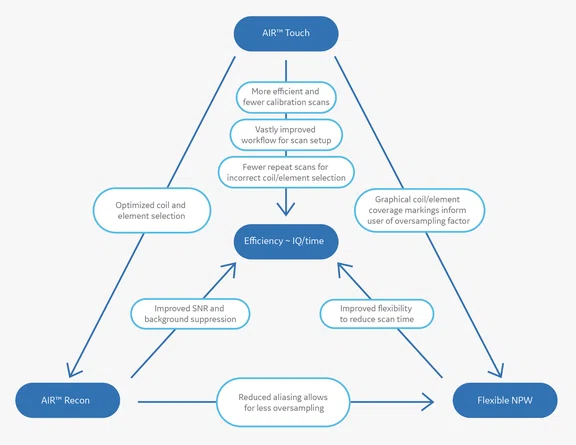
Figure 1.
The synergy of AIR Touch™, AIR™ Recon and Flexible NPW in SIGNA™Works AIR™ Edition has led to systemic improvements – image quality enhancements, artifact reduction and shorter imaging time while maintaining apparent SNR – in every exam at Shields Radiology Associates
"The big difference is that everything just looks better after the upgrade," Dr. Pechet adds. "We are scanning faster with better image quality. Even using the same protocols as the prior software version without optimization resulted in improved image quality and a more efficient technologist workflow."
With the increasing complexity of patients, technology and MR exams, SIGNA™Works AIR™ Edition delivers solutions that comprehensively address these new demands, facilitate coil selection, reduce artifacts in image reconstruction and optimize scan times, without user intervention.
Intelligent workflow
AIR Touch™ is an integral feature of SIGNA™Works AIR™ Edition and used for every exam and every patient at Shields Radiology, fundamentally changing the way the technologist works with the MR system. Landmarking is now performed once, and the system intuitively knows where the coil is located so there is no need for the technologist to select any specific coil configuration. Calibration is automatic and built into the scan, rather than the technologist having to know if and when to prescribe it. This capability feeds directly into the ability of AIR™ Recon to conduct new calibration-based image reconstruction.
Suboptimal coil selection can lead to unexpected results and/or artifacts, which happened frequently on the previous systems. Now with AIR Touch™, coil coverage is graphically depicted, ensuring the anatomy is covered, as well as enabling optimization of the oversampling using Flexible NPW. When changing field-of-view or doing multiple contiguous exams, technologists don’t have to manually select coil configurations and can move from one coil to another without having to re-landmark. Furthermore, technologists can modify the amount of Flexible NPW factor in 2D, 3D and PROPELLER imaging to visually match the extent of the coil coverage to optimize scan time and control aliasing.
AIR Touch™ also facilitates the use of Flex Coils in conjunction with the Posterior Array (PA) and other coils, delivering the coverage and SNR at the edge of the Flex Coils that is crucial for many exams. For example, in a hip or shoulder exam, Shields will use a medium Flex Coil positioned more anteriorly for the hip/shoulder and a combination of coils in the table to cover the anatomy posteromedially. Brachial plexus exams utilize the AIR™ Anterior Array (AA) Coil, the PA that is built into the table and the posterior portion of the Head and Neck Unit (HNU). "Uniformity is improved by the ability to combine coils to more optimally cover the anatomy," Dr. Pechet explains.
"The optimized coil selection and interaction with AIR™ Recon allows for the best possible SNR and a reduction in artifact, primarily wrap, annefact and phase aliasing."
Dr. Tiron Pechet
At Shields, AIR Touch™ has led to a significant reduction in repeat scans due to the automation and optimization of the coil selection. In combination with simplified one-time landmarking and graphical depiction of scan and oversampling coverage, Shields was able to achieve more consistent exams across technologists and patient body types. When AIR Touch™ is used with AIR™ Recon and Flexible NPW, "we get the best balance of artifact-free images, SNR and low scan times, and are more precise in oversampling using Flexible NPW to remove artifacts," he adds.
Nicole Teczar, Chief Technologist at the Shields Framingham, MA, site, says, "AIR Touch™ works flawlessly and selects the best coils." AIR Touch™ automatically selects the best coil element combinations for each patient. "Moreover, we save on average 23 seconds whenever a new coil-related calibration is needed, which previously could add to the overall time when performing body exams," she adds.
The automatic coil selection is especially useful in cases that require multiple MR exams, such as brain and cervical spine studies for multiple sclerosis patients. "AIR Touch™ has really improved workflow by allowing multiple locations and fields-of-view without re-localizing," Dr. Pechet says.
Exceptional image quality in faster scan times
AIR™ Recon has also significantly changed the quality of imaging produced by the technologists on the SIGNA™ Pioneer at Shields.
"It just makes everything look better," Dr. Pechet says. "In fact, the first morning after we installed SIGNA™Works AIR™ Edition, one of our radiologists, Dr. Ketan Patel, left a voicemail for me, ‘Hey Tiron, what did you do to the Pioneer?’ I was really concerned and replied immediately! But it turns out that he was looking at a couple of examinations of the hip and, although he couldn’t put his finger on it, he noticed that everything looked better on these exams, as well as others that he had reviewed using the newly installed software – with no changes made to the sequences.
That’s because of the improvements in background artifact and SNR afforded by AIR™ Recon. And that was before we started to modify the protocols to take advantage of SIGNA™Works AIR™ Edition."
Dr. Pechet has found the improvement in SNR is more noticeable on FSE images while background suppression is more apparent with PROPELLER. Overall, annefact and wrap are greatly reduced, allowing for a reduction in oversampling when using Flexible NPW, which shortens scan times while maintaining SNR, as well as fewer unexpected results and repeat sequences. The impact is most apparent on large field-of-view 3D Cube imaging.
"AIR™ Recon, in conjunction with the AIR™ AA Coil, has revolutionized how we perform brachial plexus and lumbosacral plexus imaging," Dr. Pechet adds. "We have fewer unexpected results, and many potential error points have been eliminated."
Off-center imaging is another improvement with AIR Touch™ and AIR™ Recon. For patients, this means they no longer have to maintain the "superman" position with their arms above their head. Now, they can keep their arms at their sides and the technologists can acquire high-quality images without artifacts.
Flexible NPW and AIR™ Recon deliver a better result by working in tandem. Technologists consistently try to optimize both time and image quality. Historically, it is difficult to predict how much phase oversampling is required to produce an artifact-free image. Therefore, the technologists may often add more oversampling to protect against possible wrap artifact and potentially having to repeat a sequence. This is particularly the case when imaging anatomy near the edge of the coil. With auto coil selection and the ability to graphically see the oversampling and scan area, it’s not necessary to increase oversampling beyond what the technologist can visually confirm is needed.
At Shields, technologists are now confident that they can go to the edge of what will work with respect to SNR and oversampling by using Flexible New and AIR™ Recon, and capture a great, diagnostic exam in the minimum amount of time and without risking having to repeat the sequence.
Unlocking MR’s full potential
In Dr. Pechet’s opinion, Flexible NPW has significantly evolved in the SIGNA™Works AIR™ Edition upgrade.
"Flexible NPW was introduced in a previous release, and it was a very nice feature," he says. "However, its full power was not unlocked until the arrival of AIR Touch™ and AIR™ Recon, which allow for a realistic and reliable reduction in the amount of oversampling needed for artifact-free imaging and adequate SNR."
Dr. Pechet explains that ideally, the smallest amount of oversampling needed to prevent artifacts from wrap or annefact should be applied. However, additional oversampling – beyond the minimum theoretically required – is routinely employed to "protect" against artifacts that could cause the entire sequence to be repeated, and also because additional oversampling improves SNR. AIR Touch™ and AIR™ Recon together fundamentally improve wrap and annefact rejection and accurately depict the anatomy protected from wrap. This removes the first reason for using too much oversampling because the technologist can precisely prescribe the amount of oversampling required. And, because AIR Touch™ and AIR™ Recon combine to improve SNR, the need to use oversampling to increase the SNR is reduced. The most frequent change in a pulse sequence after upgrading is the reduction in the amount of oversampling and, therefore, the scan time without adversely affecting image quality.
One of the key challenges in MR imaging is the variability between scans, from technologist to technologist and patient to patient. Scan variability is number one on Dr. Pechet’s list to improve.
"The combination of these three technologies, Flexible NPW, AIR™ Recon and AIR Touch™, has helped improve consistency from scan to scan," he says. "And they’ve helped with efficiency, as well."
Dr. Tiron Pechet
Simply better MR
AIR™, GE’s family of MR products that include AIR™ Coils, AIR™ Workflow applications and AIR™ Image Quality solutions are exciting advancements for the technologists and radiologists at Shields. Many patients undergoing an MR exam are acutely ill with complex pathology; AIR™ provides a simpler way to scan them without having to change coils or capture multiple sequences for one good view.
The brachial plexus and lumbar plexus are some of the most complicated MR exams encompassing a large anatomic area. Yet, the pathology the radiologist is looking for is quite small when considering they are trying to visualize millimeter or sub-millimeter nerve fascicles while having a field-of-view large enough to compare left and right sides of the patient.
"With AIR Touch™ and AIR™ Recon, we are doing an incredible job on brachial plexus and lumbar plexus exams," says Dr. Pechet.
C
D
Figure 5.
Spine exam comparison of (A, C) the prior software version to (B, D) SIGNA™Works AIR™ Edition performed in the same time but with improved IQ as a result of the combination of AIR Touch™, AIR™ Recon and Flexible NPW with SIGNA™Works AIR™ Edition. Underlying improvements in the pulse sequence significantly remove the dark shading on the right of the axial reformats in (C) as well as sharpness of the reformats and allow for much more consistent and repeatable imaging without need to increase TR for some patients.
SCENIC a replacement for PURE and SCIC
SCENIC is a new, more intelligent surface coil intensity correction technique that also improves consistency and efficiency. It is a complete replacement for PURE and SCIC in neurography and many musculoskeletal (MSK) exams such as the shoulder and hips. Previously, technologists had to choose to scan with either PURE or SCIC; selecting the wrong one could lead to a rescan or refilter.
"SCENIC helps deliver more consistent exams and fewer repeats as it improves overall signal homogeneity. It is much easier for the technologists to apply because they don’t have to choose between SCIC or PURE and its image processing removes some of the background noise," Dr. Pechet explains.
It makes such an impact on the image that if the technologist forgets to turn it on, the radiologist reading the study will notice the difference, Dr. Pechet adds. This, in addition to numerous other smaller improvements, like a significantly improved method to apply window and level settings so that images are depicted on PACS ready-to-read, decreases radiologist workload and improves efficiency.
Realizing the potential of isotropic imaging
One sequence that has also significantly improved in the SIGNA™Works AIR™ Edition software release is Cube.
"For a long time, Cube had enormous potential, however, it had limitations in terms of coil coverage and image reconstruction," says Dr. Pechet. "With the latest software, most of these issues have been solved. The reformats are now sharp in all planes with a more uniform slab profile. Cube is a great go-to sequence that we are consistently using more often, sometimes by itself as the only acquisition of a particular weighting such as STIR."
After the SIGNA™Works AIR™ Edition upgrade, a lumbar plexus or brachial plexus exam consists of a T1 Cube, Cube neurogram, and an isotropic T1 LAVA Flex pre- and post-contrast, as well as diffusion neurography using MUSE. Prior to the upgrade, the protocol included slab wrap and multiple 2D acquisitions in coronal and sagittal planes, which were long and often had significant artifact. The improvements in Cube, including the much improved performance of FOCUS, has allowed Shields to have 3D scan times in the range of 4-5 minutes with minimal or no artifacts and 1 mm isotropic voxel resolution.
Figure 6.
New ability to do excellent 3D Cube imaging of the knee in two sequences totaling approximately 9 min. with an isotropic resolution of approximately 0.5 mm. Sequences are (A-C) 3D PD Cube and (D-F) 3D PD T2 Cube FatSat sequence. Images were acquired in the sagittal plane (A, D) and reformatted to coronal (B, E) and axial (C, F) planes.
Figure 7.
IQ improvement in brachial plexus with AIR Touch™ and Flex Coils. AIR Touch™ now allows combination of Flex Coil + HNU + PA to significantly improve imaging of the periphery of the brachial plexus extending to the branching of the nerves in the upper arm. (A-C) All sequences are MIP reconstructions of approximately 1 mm isotropic Cube STIR neurograms using HyperCube and HyperSense. Scan time is approximately 4:30 min. (C) Example of unilateral imaging of the upper arm using medium Flex Coil in combination with HNU and PA. This was not feasible prior to SIGNA™Works AIR™ Edition.
The overall impact of the new software translates to shorter exam times and fewer repeat exams, resulting in exceptional patient care. Radiologists notice the improved image quality, especially artifact reduction, leading to less uncertainty and faster reading/reporting. The facility is able to accommodate more patients, therefore, more patients can experience this enhanced MR experience. The entire process for patients, technologists and radiologists is simply a better experience.
Adds Dr. Pechet, "GE had the vision to work on multiple issues at once and bring together this triad of solutions to move MR imaging to the next level."










